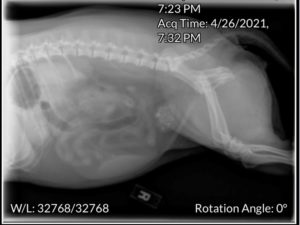When you love your pet but financial resources are limited, a veterinary emergency can lead to hours of desperate efforts to raise money and find a veterinarian that is willing to take the case on. This is just one family’s story.
When Tammy’s 5 year old Chihuahua mix, Sophie, suddenly couldn’t pee one Sunday afternoon, she knew something was dreadfully wrong.
When Sophie came back into the house, she jumped up on the couch and tried to urinate again, leaving a few dribbles. Then she jumped down and went to hide under the living room table.
None of this was characteristic of Sophie, who hadn’t had a household accident since puppyhood.
Tammy knew she and her husband had to act quickly. They scrambled into their car and headed for the nearest emergency veterinary hospital.
They arrived at 3 pm and the vet team hustled out to the car to collect Sophie.
It turned out that Sophie was suffering from a urinary tract infection caused by bladder stones. A large stone was partially obstructing her urethra, which is why she was having trouble urinating.
At this point the bill for Sophie’s care was $966.82. This covered the emergency walk-in fee, initial diagnostics including radiographs, an ECG, oxygen therapy, IV fluids, gastroprotectant medications, and pain meds.
But Sophie required further treatment to remove the obstructing stone from her urethra as well as the other stones in her bladder. She needed a cystotomy, which requires surgery under general anesthesia to open the bladder wall and remove the stones.
The estimate for the procedure was $7,000.
Tammy had already spent almost every penny she had, and that included borrowing several hundred dollars from a relative. After paying the initial $966 to find out what was wrong, Tammy had $39 left in her checking account. Tammy and her husband, who both have health problems, receive SSDI – social security disability income. While they would be receiving a check in about 5 days, it would be nowhere near the $7,000 they needed.
And unfortunately their fixed social security income meant they didn’t qualify to borrow $7,000 using the financing options that are commonly offered by most veterinary hospitals.
No Money Left, Treatment Still Needed
Since there was no money left, the hospital did the only thing they could do. They flushed the obstructing stone back up into Sophie’s bladder. They sent her home with anti-nausea and pain meds and antibiotics. They advised Tammy to find a less expensive vet who could do a cystotomy right away. Otherwise, that offending stone could once again pass from the bladder into the urethra and cause a life-threatening obstruction.
It was now 3 am on Monday morning. Tammy and her husband drove home with Sophie. For several agonizing hours, they couldn’t do much except research on their computer. They couldn’t make any calls until after 7 am when veterinary hospitals opened.
When the clock struck 7, both Tammy and her husband began frantically calling every veterinary office in their area, as well as every single potential resource they’d found on the Internet.
One of those calls came to my cell phone at about 8 am.
On the other end of the line was a very tearful and panicked Tammy, who was looking for anyone or anything that could help her dog. Her first words were “we can’t put her down. She helps my husband with his traumatic brain injury. She’s family. We just can’t put her down.”
I began by asking Tammy all the standard questions: had she reached out to family and friends for help? Yes, she said. They had borrowed all they could from one family member and they didn’t think they could borrow more, but her husband was still calling people. He was also thinking of selling his car.
The Agonizing Search for Help
I asked if she knew about crowdfunding sites for veterinary expenses like CoFund My Pet and Waggle. She didn’t, so I emailed her the links. Tammy told me that she wasn’t very computer savvy, so she had a hard time figuring out how to set up the campaigns but she was willing to try. Unfortunately, neither she nor her husband had an extensive network on social media so these options were going to be of limited help.
I also emailed her my current list of veterinary charities and together we went through several over the phone. All charities require an application, and gathering the needed documentation – including tax information, pay stubs, and the like – is very time-consuming. And if like Tammy you aren’t very familiar with computers, uploading multiple files and documents can be overwhelming.
Making things even harder was the fact that several veterinary charities still only accept applications by postal mail. We crossed those off the list because there was no way that Tammy could wait days or weeks to find out if Sophie was eligible for assistance.
While Tammy and I continued working the list of charities, I could hear her husband on the phone in the background, calling one veterinarian after another to find one that would accept a payment plan. Their regular vet, who saw Sophie for annual wellness visits, told him they would be happy to treat Sophie but they needed a $1000 down payment, which was out of the question.
The phone calls to vets continued apace.
I also contacted Carol Smock, a member of VetBilling’s Advisory Board and the founder and director of Brown Dog Foundation, which provides charitable funding for veterinary care. Carol helped guide Tammy through Brown Dog’s online application process.
At 3 o’clock in the afternoon, one of the last veterinary practices on Tammy’s call list agreed to admit Sophie on an emergency basis. They estimated the cost of the procedure to be about $1200, and asked for 1/3 down. The rest could be paid for in monthly installments. Tammy booked the appointment and then she and her husband went right back to working the phones, to see if they could raise $400 from various friends and relatives in the next couple of hours.
By early evening, Tammy and her husband had managed to scrape together the necessary $400 for the required down payment. They set off for the hospital. Sophie was admitted and scheduled for surgery first thing the following morning.
A Happy Ending But Uncomfortable Questions Remain
Fortunately this story has a happy ending. Sophie’s bladder stones were removed, including the large stone that had in fact slipped back down into the urethra despite having been flushed back into the bladder. It was a difficult procedure and Sophie remained hospitalized for 3 days. She’s back home now, no longer wearing her “cone of shame,” and acting like her old self. She’s on a new diet to help reduce the chances that she’ll form new stones.
Brown Dog Foundation provided a grant to help Tammy’s family manage the cost of care, but it took a few days to arrange this so a payment plan was still necessary.
I’ve shared this story to shine a light on what really happens when pet owners can’t manage the upfront cost of urgent veterinary care. Where do they go after leaving the hospital that tells them they can’t take payments? What do they do? Where can they turn and how do they begin the process of seeking help?
It’s too easy to say of this family, “well, they shouldn’t have a pet if they can’t afford it.” But they’ve been able to afford Sophie’s care for 5 years without any issues. Jumping to that conclusion fails to take into consideration all the things that have gone right in Sophie’s life so far: she is well-loved, well cared for, and sees her vet regularly. She is an important and integral part of her family, and she provides emotional support to someone with a traumatic brain injury. I’m personally not comfortable with the idea that lower income families shouldn’t have pets.
Is Pet Insurance the Answer?
One thing I know we’ll hear is that Sophie’s parents should get pet insurance. But please keep in mind that even with pet insurance, they still would have had to pay for Sophie’s care up front, and then wait to be reimbursed.¹
What happens when you just don’t have thousands of dollars readily available in cash or credit? Pet insurance helps after you’ve already spent the money. This is great for pet owners who can afford to pay the upfront cost – they’ll be reimbursed and will recoup a significant portion of the cost. And for procedures that don’t cost thousands of dollars it can be a wonderful tool for managing veterinary expenses.
But unlike human health insurance, or even other insurance products like auto collision – pet insurance does not protect you from potentially catastrophic out-of-pocket costs, at least not initially.¹
There are no easy answers here. But Sophie’s parents weren’t looking for a handout. They didn’t want or expect free care. They weren’t angry about the cost of veterinary care, they just wanted to find an affordable price point and be given the opportunity to make payments over time.
They put enormous effort into helping themselves when they were facing a potentially tragic situation.
How to Be Financially Prepared for a Veterinary Emergency
There are thousands of other families who have similar stories. I simply want readers to feel, experience, understand, and empathize with the fear and stress that pet owners endure when they’re desperate to find a way to pay for a pet whose life is hanging in the balance.
And if this helps alert pet owners to the fact that yes, this can happen to your pet too, it might be time to look into an affordable insurance policy, and start a savings fund. You should do both – remember that pet insurance is a reimbursement model so you will need to have money available to pay your invoice at the time services are received.
Online savings accounts like Marcus by Goldman Sachs and Chime are free and allow you to automatically transfer money from your checking account into a savings account, in whatever amount and on whatever schedule suits you. It is easy to transfer accumulated savings right back into your checking account when you need it (fund transfers typically take 24-48 hours to show up in your account.) You can do everything right from your smartphone, too. You can set aside as little as $5 to $10 a week, which means you’re saving $20 to $40 a month, or $240 – $480 a year!
A good rule of thumb is to make sure that at all times you have access to about $1,500 in cash or credit, if at all possible. That $1,500 is usually enough to get emergency services started and buys you a little extra time to identify additional sources of funding or move money from one account to another.
Pet owners and veterinarians both have a role to play when it comes to eliminating cost as a barrier to veterinary care. Pet owners should educate themselves about the cost of care and proactively plan for emergencies (a good place to learn about costs is Pawbly, an online community where pet owners share their pets’ health stories.)
Veterinarians can expand the variety of financing options they offer and make sure they have tools like VetBilling in place to help pet owners who don’t qualify for credit (over 60% of applicants are declined, including some who have good credit – learn why in a related blog post, “Excellent Credit Score, Declined for Credit: Yes, It Happens to Your Veterinary Clients.”)
My hope is that we can collectively identify sustainable ways to financially assist these families in their moment of need, so pets can stay in the loving homes they already have.
I’m so glad that Sophie was able to stay in hers.
¹ Exceptions: Trupanion pet insurance offers direct payment to veterinarians who participate in the Trupanion Express program. For other pet insurance providers, sometimes the veterinary practice can make a call on the pet owner’s behalf to see if the vet can be paid directly. Veterinary hospitals don’t routinely offer this service because it is time-consuming, but pet owners who can’t manage to pay the upfront cost can and should advocate for themselves and ask about it.
You can also ask for a short-term payment plan and then pay off your balance when your reimbursement check comes, or ask your pet insurance provider to send the funds directly to your veterinarian to satisfy your outstanding balance. These aren’t usual and customary practices but pet owners shouldn’t be afraid to openly request alternative solutions.
For more information about pet insurance, please visit Your Pet Insurance Guide or listen to the Pet Insurance Guide Podcast, hosted by Dr. Doug Kenney.



